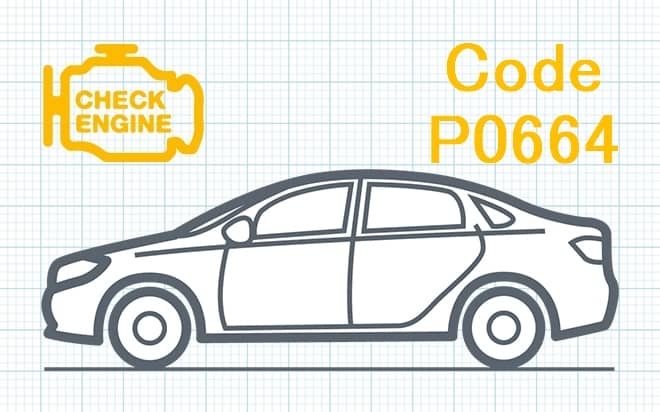
P0664 Low signal in the intake manifold tuning valve control circuit, bank 2
Content
P0664 – OBD-II Trouble Code Technical Description
Intake manifold tuning valve control circuit low bank 2
What does the fault code mean P0664?
Code P0664 is a generic OBD-II trouble code that indicates a problem in the intake manifold tuning valve control circuit on engine bank 2, that is, bank without cylinder number 1. This circuit is controlled by the engine control module (PCM) and other modules such as the cruise control module, traction control module and transmission control module. When one of these modules detects an error in the intake manifold valve control circuit, a P0664 code may be activated.

Possible reasons
Causes of a P0664 code may include:
- The intake manifold adjustment valve (slider) is faulty.
- Damage to valve components.
- Stuck valve.
- Extreme cold conditions.
- Wiring problems such as frays, cracks, corrosion and other damage.
- Broken electrical connector.
- Problems with the ECM (engine control module).
- Valve contamination.
Additionally, causes of the P0664 trouble code may include:
- Faulty PCM (engine control module) driver.
- Broken control module ground wire.
- Loose control module grounding belt.
- Faulty fuel injector control module.
- In rare cases, a faulty PCM or CAN bus.
- Faulty electrical components in the PCM or CAN bus (controller area network).
Careful diagnosis is necessary to accurately determine the cause of the P0664 code in a particular case.
What are the symptoms of a fault code? P0664?
The P0664 code is usually accompanied by a Check Engine light that illuminates on the dashboard. In this case, the car may exhibit the following symptoms:
- Delay in acceleration.
- Rough engine idling.
- Frequent engine stops.
- Reduced fuel efficiency.
Additional symptoms associated with diagnostic code P0664 may include:
- Poor engine performance.
- Strong clicking sound coming from the engine compartment.
- Reduced fuel economy.
- Possible misfire when starting.
- Reduced engine power.
- Changing the power range.
- Cold start problems.
How to diagnose a fault code P0664?
To diagnose and resolve the DTC, follow these steps:
- Check Technical Service Bulletins (TSBs) for known problems with your vehicle.
- Clear the fault codes and see if they appear again after a test drive.
- Locate the intake manifold tuning valve and visually inspect it for damage.
- If possible, operate the valve using an OBD2 scanner to determine if it is working properly.
- Check the wiring harness associated with the valve for damage or wear.
- If the problem remains unresolved, contact the ECM (engine control module) for additional diagnostics.
Always follow the technical data and service bulletins for your specific vehicle.
Diagnostic errors
When diagnosing a P0664 code, the most common mistake is not following the OBD-II diagnostic protocol correctly. It is important to strictly adhere to this protocol to ensure effective diagnosis and avoid erroneous repair actions.
It happens that the P0664 code is accompanied by other trouble codes that may occur in response to communication errors caused specifically by the P0664 code. These related codes can sometimes be detected before the P0664 code appears, and misinterpreting their meaning can lead to incorrect repair actions.
How serious is the fault code? P0664?
Trouble code P0664 is not a critical problem in and of itself, but its severity may depend on how it affects your vehicle's performance and your specific circumstances. This code indicates problems with the intake manifold tuning valve on a number of 2 engines, which can affect engine performance and efficiency.
Symptoms associated with a P0664 code may include poor engine performance, loss of power, worse fuel economy, and other performance problems. In rare cases, this may cause an incorrect cold start.
If high performance and fuel efficiency are not critical to you, then the P0664 code can probably be ignored for the short term. However, it is recommended to diagnose and repair this problem as soon as possible to avoid further deterioration and damage to the engine.
What repair will help eliminate the code? P0664?
The following repair steps may be required to resolve DTC P0664:
- Reprogram the PCM (engine control module) or update drivers to resolve the error.
- Replace electrical components such as sensors or wires if they are found to be faulty.
- Replace ground wires or ground strips to ensure reliable electrical communication.
- If necessary, replace the fuel injector control module if this is the source of the problem.
- In rare cases, the PCM (engine control module) or CAN bus may need to be replaced if the problem is with these components.
Repairs should be carried out by professionals or experienced mechanics as they may require special tools and knowledge. Diagnosing and fixing the problem can be difficult, so it is important to contact a professional for proper repairs.
P0664 – Brand-specific information
Trouble code P0664 can occur on different makes of vehicles. Here are some of them with transcripts:
- Ford – Intake manifold tuning valve control circuit low.
- Honda – Intake manifold tuning valve control signal low voltage.
- Toyota – Intake manifold tuning valve control error.
- Chevrolet – Intake manifold tuning valve voltage low.
- Nissan – Intake manifold tuning valve control signal low.
- Subaru – Error in the operation of the intake manifold tuning valve.
- Volkswagen – Low signal level at the intake manifold tuning valve.
- Hyundai – Intake manifold tuning valve control error.
This is just a small list of brands on which the P0664 code may occur. The code may vary slightly depending on the manufacturer, so it is always recommended to consult the official documentation or service center for your specific vehicle make and model.

